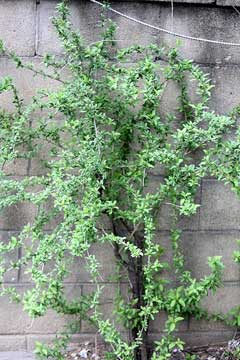
Chinese Boxthorn, Chinese desert-thorn
Latin Name: Lycium chinense
USDA Hardiness: 5-9
Native Range: TEMPERATE ASIA: Mongolia (south), China (Anhui Sheng, Fujian Sheng, Gansu Sheng (south), Guangdong Sheng, Guangxi Zhuangzu Zizhiqu, Guizhou Sheng, Hainan Sheng, Hebei Sheng, Heilongjiang Sheng, Henan Sheng, Hubei Sheng, Hunan Sheng, Jiangsu Sheng, Jiangxi Sheng, Jilin Sheng, Liaoning Sheng, Nei Mongol Zizhiqu, Ningxia Huizi Zizhiqu, Qinghai Sheng, Shaanxi Sheng, Shanxi Sheng, Sichuan Sheng, Xinjiang Uygur Zizhiqu, Yunnan Sheng, Zhejiang Sheng), Korea, Japan (Hokkaidô, Honshu, Kyushu, Ryukyu Islands, Shikoku), Taiwan TROPICAL ASIA: Thailand
Edibility Rating: 4 / 5
Medicinal Rating: 3 / 5
Region:
Family:
Plant Type:
Medicinal Uses
Edible Uses
Edible Parts: Fruit Leaves Seed Shoots | Edible Uses: Coffee TeaFruit - raw, cooked in soups etc or dried for later use[174, 178, 183]. Sweet with an aniseed-like flavour[183]. The fruit is an oblong berry about 15mm long by 8mm wid[266]. Only the fully ripe fruits should be eaten[K]. Leaves and young shoots - raw or cooked[61, 174, 178]. A peppermint-like flavour, the leaves are used in salads or used as a potherb[183]. Rich in vitamin A., the leaves also contain about 3.9% protein, 2.25% carbohydrate, 0.7% fat, 1.4% ash[179]. The roasted seed is a coffee substitute[183]. The dried leaves are a tea substitute[183].
Cultivation
An easily grown plant, it does not require a rich soil, flowering and fruiting better in a well-drained soil of moderate quality[1, 11, 200]. Succeeds in impoverished soils[200]. Requires a sunny position[200]. Tolerates maritime exposure[200]. A very hardy plant tolerates temperatures to about -23°c[200]. This species is widely cultivated for its edible young shoots in China. There is much confusion between this species and the closely related L. barbarum. Most, if not all, of the plants being grown as L. chinense in Britain are in fact L.barbarum[11, 50, 200]. Goji berries are usually harvested in late summer to early autumn when the berries are fully ripe and have turned bright red. Lycium species generally flower in late spring to early summer producing small, tubular flowers that can be purple or white. Lycium species are moderately fast-growing plants. Depending on growing conditions, they often reach a height of about 1 to 3 meters (3 to 10 feet) within a couple of years.
Known Hazards
Some caution should be exercised with this species, particularly with regard to its edible leaves, since it belongs to a family that often contains toxins. However, use of the leaves is well documented and fairly widespread in some areas.
Habitats
Thickets and river banks in lowland C. and S. Japan[58].
